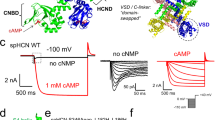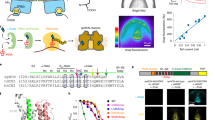Abstract
In excitable cells, ions permeate the cell membrane through ionic channels, some of which open and close in response to changes in the potential difference across the membrane. It has been supposed that this opening and closing (or gating) process is largely independent of the permeating ion. However, we show here that the gating of the resting potassium permeability of frog skeletal muscle depends on the species of ion which carries current across the membrane. The potassium permeability investigated allows K+ to move in across the membrane more easily than out1,2. This property is known as inward or anomalous rectification and is shared by cell membranes of skeletal muscle1–3, egg4 and certain other cells5–7. In both egg cells8 and skeletal muscle fibres9, the group IIIB metal ion T1+, which can replace K+ in several other systems in experimental conditions10–12, also permeates the inward rectifier. Indeed, Tl+ is more permeant than K+ (refs 8, 9). However, when Tl+ carries current inwards across the membrane, the inward rectifier inactivates over a brief period when the membrane is hyper-polarized, whereas when K+ carries current, the permeability increases with time under hyperpolarization.
This is a preview of subscription content, access via your institution
Access options
Subscribe to this journal
Receive 51 print issues and online access
$199.00 per year
only $3.90 per issue
Buy this article
- Purchase on Springer Link
- Instant access to full article PDF
Prices may be subject to local taxes which are calculated during checkout
Similar content being viewed by others
References
Katz, B. Archs Sci. Physiol. 3, 285–299 (1949).
Hodgkm, A. L. & Horowicz, P. J. Physiol., Land. 148, 127–160 (1959).
Adrian, R. H. & Freygang, W. H. J. Physiol., Lond. 163, 104–114 (1962).
Hagiwara, S. & Takahashi, K. J. Membrane Biol. 18, 61–80 (1974).
Hall, A. E., Hutter, O. F. & Noble, D. J. Physiol., Lond. 166, 225–240 (1963).
Kandel, E. R. & Tauc, L. J. Physiol., Lond. 183, 287–304 (1966).
Nelson, P. G. & Frank, K. J. Neurophysiol. 30, 1097–1113 (1967).
Hagiwara, S., Miyazaki, S., Krasne, S. & Ciani, S. J. gen. Physiol. 70, 269–281 (1977).
Gay, L. A. thesis, Univ. Leicester (1979).
Cavieres, J. D. & Ellory, J. C. J. Physiol., Lond. 243, 243–266 (1974).
Hille, B. J. gen. Physiol. 61, 669–689 (1973).
Hughes, M. N., Man, W. K. & Whaler, B. C. J. Physiol., Lond. 256, 126P–127P (1976).
Adrian, R. H., Chandler, W. K. & Hodgkin, A. L. J. Physiol., Lond. 208, 607–644 (1970).
Almers, W. thesis, Univ. Rochester (1971).
Hestrin, S. Soc. Neurosci. Abstr. 5, 292 (1979).
Hagiwara, S., Miyazaki, S. & Rosenthal, N. P. J. gen. Physiol. 65, 621–638 (1976).
Adrian, R. H. & Freygang, W. H. J. Physiol., Lond. 163, 61–103 (1962).
Standen, N. B. & Stanfield, P. R. J. Physiol., Lond. 294, 497–520 (1979).
Almers, W. J. Physiol., Lond. 225, 33–56, 57–86 (1972).
Standen, N. B. & Stanfield, P. R. J. Physiol., Lond. 280, 169–191 (1978).
Adrian, R. H., Chandler, W. K. & Hodgkin, A. L. J. Physiol., Lond. 208, 645–668 (1970).
Brehm, P. & Eckert, R. Science 202, 1203–1206 (1978).
Tillotson, D. Proc. Natn. Acad. Sci. U.S.A. 76, 1497–1500 (1979).
Ashcroft, F. M. & Stanfield, P. R. J. Physiol., Lond. 308, 36P (1980).
Stanfield, P. R. & Ashcroft, F. M. Proc. IUPS 14, 716 (1980).
Author information
Authors and Affiliations
Rights and permissions
About this article
Cite this article
Stanfield, P., Ashcroft, F. & Plant, T. Gating of a muscle K+ channel and its dependence on the permeating ion species. Nature 289, 509–511 (1981). https://doi.org/10.1038/289509a0
Received:
Accepted:
Issue Date:
DOI: https://doi.org/10.1038/289509a0
This article is cited by
-
Ion-conformational interaction and charge transport through channels of biological membranes
Journal of Biological Physics (1993)
-
Gating kinetics of ATP-sensitive single potassium channels in myocardial cells depends on electromotive force
Pfl�gers Archiv European Journal of Physiology (1988)
-
Barium-induced blockade of the inward rectifier in calf Purkinje fibres
Pfl�gers Archiv European Journal of Physiology (1984)
-
The interaction of “K+-like” cations with the apical K+ channel in frog skin
The Journal of Membrane Biology (1983)
-
Poorly selective cation channels in the skin of the larval frog (Stage≤XIX)
Pflügers Archiv (1982)
Comments
By submitting a comment you agree to abide by our Terms and Community Guidelines. If you find something abusive or that does not comply with our terms or guidelines please flag it as inappropriate.



